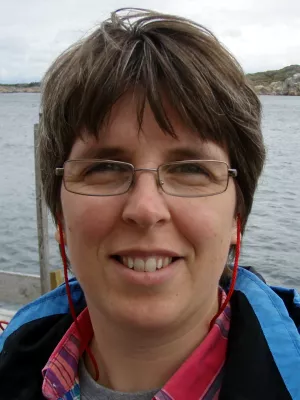
Helena Alexanderson
Professor

Late-Holocene relative sea-level changes and palaeoenvironment of the Pre-Viking Age ship burials in Salme, Saaremaa Island, eastern Baltic Sea
Author
Summary, in English
Two unique Pre-Viking Age ship burials were found from Salme village, Saaremaa Island, eastern Baltic Sea, containing remains of seven men in the smaller and 34 men in the larger ship. According to the archaeological interpretations, these ships belonged to a viking crew possibly from the Stockholm-Mälaren region, eastern Sweden. Geoarchaeological research was conducted in the area to reconstruct Late-Holocene relative sea-level (RSL) changes and shoreline displacement to provide environmental context to these burials. In this paper we present a Late-Holocene shore displacement curve for the Saaremaa Island and GIS-based palaeogeographic reconstructions for the Salme area. The curve shows an almost linear RSL fall from 5.5 to 0.8 m a.s.l. between 1000 BC and 1300 AD with an average rate of 2 mm/year. A slowdown in regression may be attributed to accelerated sea-level rise after the Little Ice Age and during the industrial period, being consistent with the tide-gauge measurements from the 20th century. Palaeogeographic reconstructions indicate the existence of a strait in the Salme area during the burial of the ships. The eastern part of the strait with water depth up to 2.8 m was about 80–100 m wide. The relatively steep and wind-protected shores in that part of the strait were probably the best places in the area for landing the viking ships. According to sedimentological evidence and diatom data, the narrowing of Salme palaeostrait occurred between 1270 and 1300 AD. Salme I and II ships were buried at 650–770 AD into the sandy-gravelly coastal deposits which had accumulated there in the open coastal zone about 710–450 years earlier. Reconstructions show that the ships were located about 2–2.5 m above coeval sea level and more than 100 m from the coastline. Thus, both ships were probably moved from the shore to the higher ground for burial.
Department/s
- Quaternary Sciences
Publishing year
2021-12-29
Language
English
Publication/Series
Holocene
Document type
Journal article
Publisher
SAGE Publications
Topic
- Geology
Keywords
- Baltic Sea
- late-Holocene
- palaeogeography
- Pre-Viking Age
- sea-level changes
- shore displacement
Status
Published
ISBN/ISSN/Other
- ISSN: 0959-6836

